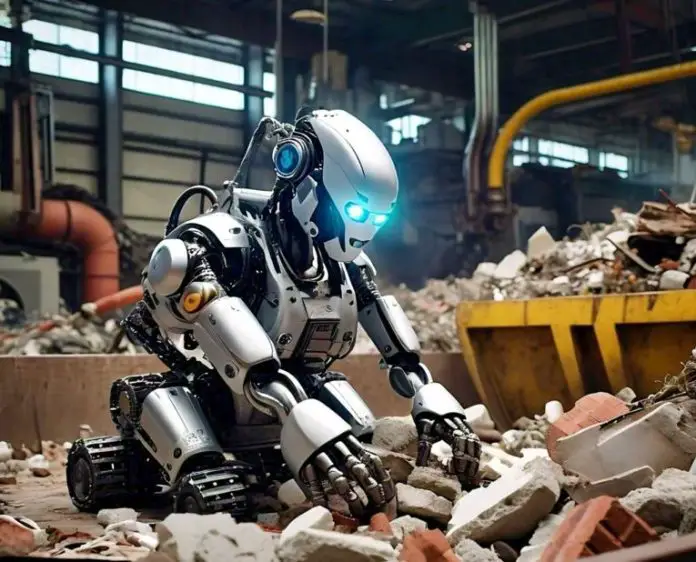Every year, the construction industry generates a staggering amount of waste. Recent statistical figures in the UK indicate that 62% of the country’s waste comes from the construction industry, which also converts to 32% of all waste sent to landfills. Estimates suggest around 2.2 billion tons of construction and demolition waste are produced globally each year, and this number is expected to rise further.
This massive volume of waste not only has severe environmental impacts but also poses significant challenges for construction companies and environmental engineers striving to comply with strict legal requirements.

In this blog post, we’ll explore how innovative technology is revolutionizing the management and recycling of construction waste. By the end, you’ll have a clearer understanding of the benefits technology brings to waste management and how your company can adopt more sustainable practices.
Construction and Demolition Wastes
Construction and demolition (C&D) activities generate a substantial portion of the global waste stream, posing a significant environmental and resource management challenge. This section provides a technical overview of the primary constituents of construction and demolition waste.
- Mineral Waste: Concrete and asphalt debris are major components of construction and demolition wastes. Crushed rock, aggregates from road construction and maintenance, and demolition of concrete structures contribute significantly. These materials often require crushing and processing for reuse as recycled aggregates in new construction projects.

- Wood Waste: Offcuts, damaged lumber, and dismantled wood elements from construction and renovation activities contribute considerably to C&D waste. Improved prefabrication techniques and on-site wood waste management strategies can significantly reduce this component.
- Masonry Waste: Sandcrete blocks, bricks, tiles, and other masonry products also represent a substantial portion of C&D waste. Advancements in crushing and sorting technologies have enabled increased recycling of these materials into construction fill or even new masonry units.
- Gypsum Waste: Drywall panels which are common in modern construction, contribute a significant volume of C&D waste. Recycling gypsum presents challenges due to potential contamination and the hygroscopic nature of the material. However, advancements in processing techniques are enabling increased gypsum waste diversion from landfills.
- Metallic Waste: Scrap metal from roofing, electrical wiring, piping, and other building components represents a valuable recyclable component of C&D waste. Effective sorting and processing techniques allow for the recovery of various metals for use in new construction products.

Beyond these primary categories, construction and demolition waste may also encompass:
- Glass Waste: Window panes, architectural glass, and glazing materials contribute a smaller portion of the overall waste stream.
- Plastic Waste: Plastic piping, insulation materials, and various construction membranes can also be present in construction and demolition waste.
- Hazardous Materials: Asbestos-containing materials, lead paint chips, and residual solvents require careful handling and disposal due to their potential health and environmental risks.
The effective management of C&D waste necessitates a multifaceted approach. Source reduction strategies through improved design, prefabrication, and material selection can significantly reduce waste generation. Furthermore, advancements in recycling technologies and robust waste segregation protocols are important for diverting recoverable materials from landfills and promoting a more sustainable construction industry.
Problems of Construction Waste Management
Effective management of construction and demolition waste presents a multifaceted challenge for stakeholders across the construction lifecycle. Some of these challenges are discussed below:
- Waste Characterization and Segregation: C&D waste encompasses a diverse range of materials, including concrete, asphalt, wood, metals, and hazardous elements. Improper characterization and inadequate segregation at the source hinder effective recycling and reuse opportunities.

- Logistics and Infrastructure Constraints: Construction sites often lack dedicated space for waste segregation and storage. Limited access to appropriate waste processing facilities and logistical complexities in transporting various waste streams further exacerbate the challenge.
- Economic Considerations: Virgin materials are often cheaper than recycled alternatives due to economies of scale and established supply chains. The cost of transportation, processing, and quality control for recycled C&D materials can make them less attractive.
- Policy and Regulatory Frameworks: Inconsistent or inadequate policies governing C&D waste management, coupled with a lack of enforcement mechanisms, can hinder progress towards sustainable practices. Furthermore, a complex web of regulations across different waste streams can create confusion and impede responsible management.
- Lack of Awareness and Training: Limited awareness among construction professionals regarding waste minimization strategies, recycling opportunities, and best practices for C&D waste management can hinder effective implementation. Inadequate training for workers in waste segregation and handling protocols further exacerbates the issue.
- Short-Term Project Focus: The construction industry often prioritizes project timelines and budgets, potentially leading to overlooking opportunities for waste reduction and reuse. A shift towards life-cycle thinking and incorporating sustainable practices throughout the project lifecycle is crucial.
Innovative Solutions in Construction Waste Management
The construction industry is constantly evolving, and waste management is no exception. Here are some innovative solutions that are tackling the challenge of construction and demolition (C&D) waste:
Innovative Sorting Methods
Innovative sorting methods have significantly advanced the efficiency and effectiveness of construction waste management. Modern technologies such as artificial intelligence (AI) and machine learning are being leveraged to automate the sorting process, ensuring accurate separation of materials like concrete, wood, metals, and plastics.
Advanced sensors and robotic systems can identify and categorize waste in real time, reducing the risk of human error and increasing recycling rates. Additionally, mobile apps and software solutions are now available to track and manage waste streams, providing construction companies with valuable data to optimize their recycling practices.
These technologies not only streamline the sorting process but also contribute to a more sustainable construction industry by diverting waste from landfills and promoting the reuse of valuable materials.
Recycling Innovations
Recycling construction waste has reached new heights thanks to cutting-edge technologies. Waste management specialists at UK Construction Waste Co. recommend working with construction waste recycling facilities that implement advanced recycling methods that transform waste into reusable resources. For example, reclaimed concrete can be crushed and used as aggregates for new building projects, while metals and wood can be processed for various applications.
These innovative recycling methods not only reduce the burden on landfills but also conserve natural resources and decrease the carbon footprint of construction activities. By adopting these practices, companies can significantly enhance their sustainability efforts, meeting legal requirements and garnering positive environmental impact.
Efficient Processing Techniques
Recycling and processing of construction waste go hand in hand, so innovations must apply to both areas. Efficient processing techniques are pivotal in transforming construction waste into reusable materials, reducing the environmental burden. Innovative methods such as crushing, grinding, and screening are used to process waste materials like concrete, asphalt, and wood.
These processed materials can then be reintegrated into new construction projects, promoting a circular economy. Additionally, advancements in thermal and chemical processing have enabled the conversion of waste into valuable resources such as synthetic fuels and raw materials for the production of new construction products.
This not only minimizes the waste sent to landfills but also conserves natural resources by reducing the need for virgin material extraction. By adopting these advanced processing techniques, construction companies can significantly enhance their sustainability efforts while also adhering to stringent regulatory requirements.
Conclusion
Technology is undeniably transforming the way we manage and recycle construction waste. From AI-powered sorting systems to advanced recycling techniques, these innovations are helping construction companies and environmental engineers tackle the waste problem more efficiently and sustainably. By adopting these technologies, businesses can not only comply with legal requirements but also reduce their environmental footprint and save costs.
If you’re ready to take the next step towards a more sustainable future, consider exploring how these technologies can benefit your organization. Let’s work together to build a cleaner, greener, and more efficient construction industry.










